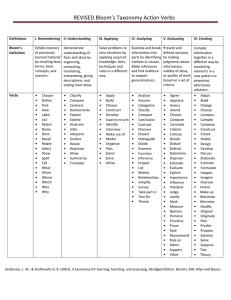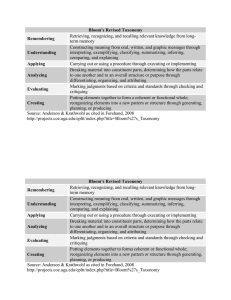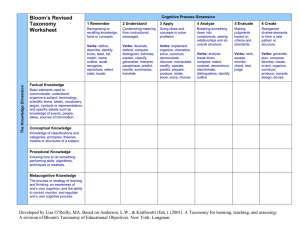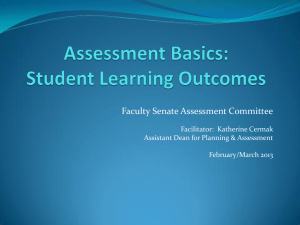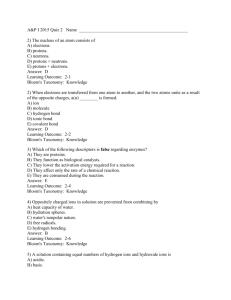Bloom's Taxonomy: Higher-Order Thinking Skills Guide
advertisement
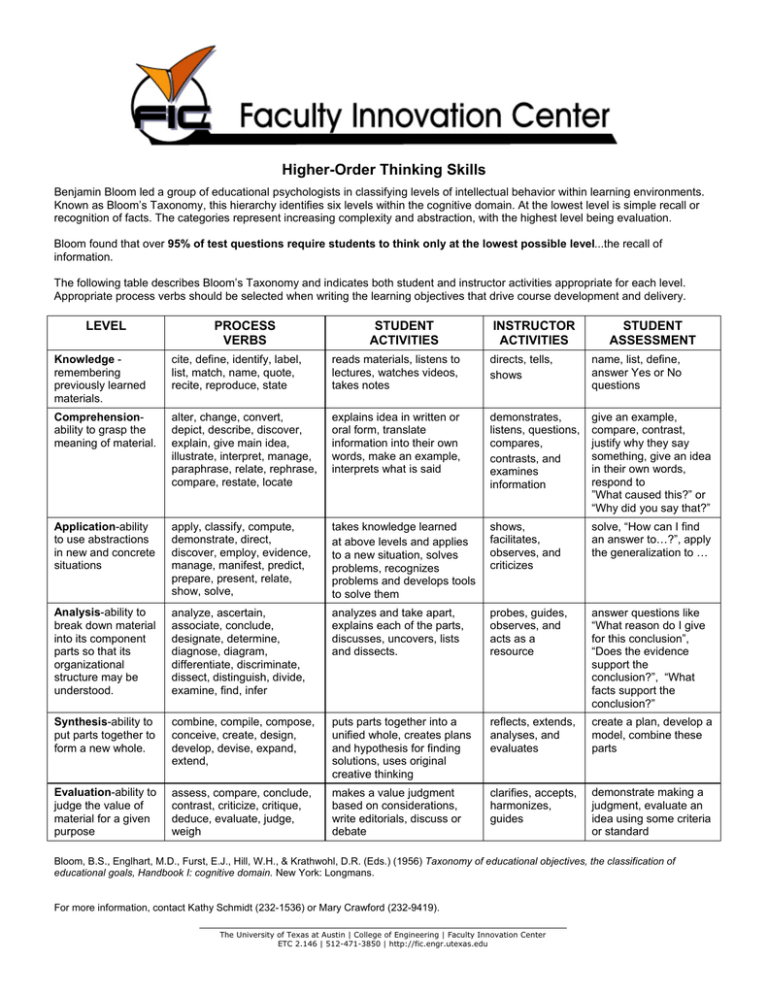
Higher-Order Thinking Skills Benjamin Bloom led a group of educational psychologists in classifying levels of intellectual behavior within learning environments. Known as Bloom’s Taxonomy, this hierarchy identifies six levels within the cognitive domain. At the lowest level is simple recall or recognition of facts. The categories represent increasing complexity and abstraction, with the highest level being evaluation. Bloom found that over 95% of test questions require students to think only at the lowest possible level...the recall of information. The following table describes Bloom’s Taxonomy and indicates both student and instructor activities appropriate for each level. Appropriate process verbs should be selected when writing the learning objectives that drive course development and delivery. LEVEL PROCESS VERBS STUDENT ACTIVITIES INSTRUCTOR ACTIVITIES STUDENT ASSESSMENT Knowledge remembering previously learned materials. cite, define, identify, label, list, match, name, quote, recite, reproduce, state reads materials, listens to lectures, watches videos, takes notes directs, tells, shows name, list, define, answer Yes or No questions Comprehensionability to grasp the meaning of material. alter, change, convert, depict, describe, discover, explain, give main idea, illustrate, interpret, manage, paraphrase, relate, rephrase, compare, restate, locate explains idea in written or oral form, translate information into their own words, make an example, interprets what is said demonstrates, listens, questions, compares, contrasts, and examines information give an example, compare, contrast, justify why they say something, give an idea in their own words, respond to ”What caused this?” or “Why did you say that?” Application-ability to use abstractions in new and concrete situations apply, classify, compute, demonstrate, direct, discover, employ, evidence, manage, manifest, predict, prepare, present, relate, show, solve, takes knowledge learned at above levels and applies to a new situation, solves problems, recognizes problems and develops tools to solve them shows, facilitates, observes, and criticizes solve, “How can I find an answer to…?”, apply the generalization to … Analysis-ability to break down material into its component parts so that its organizational structure may be understood. analyze, ascertain, associate, conclude, designate, determine, diagnose, diagram, differentiate, discriminate, dissect, distinguish, divide, examine, find, infer analyzes and take apart, explains each of the parts, discusses, uncovers, lists and dissects. probes, guides, observes, and acts as a resource answer questions like “What reason do I give for this conclusion”, “Does the evidence support the conclusion?”, “What facts support the conclusion?” Synthesis-ability to put parts together to form a new whole. combine, compile, compose, conceive, create, design, develop, devise, expand, extend, puts parts together into a unified whole, creates plans and hypothesis for finding solutions, uses original creative thinking reflects, extends, analyses, and evaluates create a plan, develop a model, combine these parts Evaluation-ability to judge the value of material for a given purpose assess, compare, conclude, contrast, criticize, critique, deduce, evaluate, judge, weigh makes a value judgment based on considerations, write editorials, discuss or debate clarifies, accepts, harmonizes, guides demonstrate making a judgment, evaluate an idea using some criteria or standard Bloom, B.S., Englhart, M.D., Furst, E.J., Hill, W.H., & Krathwohl, D.R. (Eds.) (1956) Taxonomy of educational objectives, the classification of educational goals, Handbook I: cognitive domain. New York: Longmans. For more information, contact Kathy Schmidt (232-1536) or Mary Crawford (232-9419). The University of Texas at Austin | College of Engineering | Faculty Innovation Center ETC 2.146 | 512-471-3850 | http://fic.engr.utexas.edu
